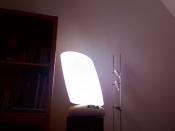short essay not entirely in depth could have been more detalied about function of hormones
Seasonal Affective Disorder
Seasonal Affective Disorder, or SAD, is a common problem of people living in northern United States. People who are affected by this disorder commonly suffer from depression, lethargy, inability to concentrate, overeating and weight gain. People from the north tend to suffer more from this disorder because of the shortened days. It appears, that due to the deficiency of sunlight some people suffer from these symptoms. The shortened days have a hormonal effect on the body that causes these symptoms, and the use of artificial sunlight is the best way to relieve the disorder.
It was not until recently that SAD was discovered. It was discovered by Peter Mueller, who was reviewing a case of a 29-year-old woman. He had noticed a pattern, the woman's depression came in the winters and left in the spring.
Over the course of years the woman moved from city to city. Mueller noticed, that the farther north she moved the early the depression. Mueller had begun to speculate that the lack of sunlight had contributed to the women's depression. In order to confirm this he exposed the patient to artificial sunlight. He found that over a period of time the patient had recovered from the depression. Today light therapy is the most commonly used method in treating SAD.
The two hormones that are affected by the sunlight, and are thought to be the cause of SAD, are melatonin and serotonin. Both of these chemicals "are influenced by photoperiodism, the earth's daily dark-light cycle" (Wurtman 1989). Melatonin is the chemical that effects mood and energy levels. In the human body melatonin is at its highest at night and is lowest in the day. There has been...


